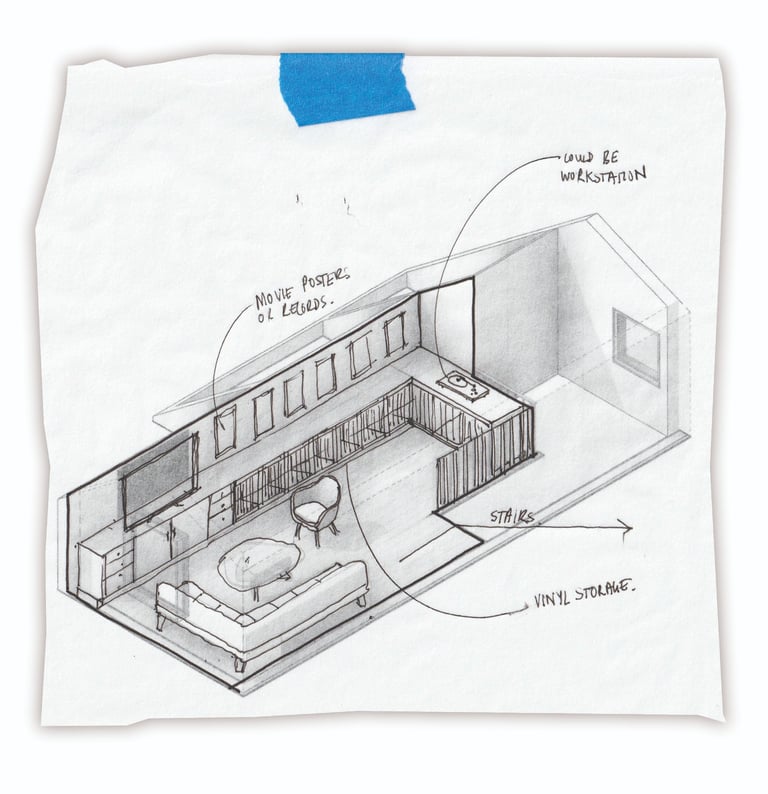2025 Seattle Interim Zoning Legislation
As of June 30, 2025, Seattle has enacted an Interim Zoning Ordinance in direct response to HB 1110 — the statewide mandate requiring jurisdictions to support middle housing. This interim update to the zoning code is set to remain in effect for one year, unless extended or replaced.
Middle Housing refers to residential types that fall between single-family homes and large apartment complexes — such as duplexes, fourplexes, stacked flats, cottage housing, and townhouses. The intent is to increase density, diversify housing options, and create more affordable pathways to homeownership.
Every residential lot can host up to 4 dwelling units
Base height limits have increased to 32 feet
There are new zoning bonuses based on density
ADU regulations have been moved to a new section
Tree protection laws have remained the same
This legislation is valid for one year until June 30, 2026
But the path to adoption has been anything but simple. The rollout of this legislation has been marked by legal challenges, multiple drafts, and substantial revisions. Understanding what’s actually in effect right now can be a real challenge — that’s where we come in.
We’ve put together a clear breakdown below. Read on for a summary of how rules have changed across neighborhood residential zones, updates to ADU allowances that may have flown under the radar, and some thoughts on what this interim legislation signals for the city’s long-term housing policy.
DENSITY 23.44.017
How many homes you can build on your lot
Up to 4 Dwelling Units are permitted per lot in all neighborhood residential zones
Up to 6 Dwelling Units are permitted per lot if within a quarter mile walking distance of a major transit stop or at least two affordable principal dwelling units are provided
(Previously in NR1, NR2, and NR3 zones, only one single-family dwelling was allowed per lot, with up to two ADUs under certain circumstances. In RSL zones, one principal dwelling unit was allowed per 2,000 SF per lot area with up to one ADU)
Notes and Exceptions
ADUs count towards density limits
(Previously, ADUs did not count towards density limits)Up to two accessory dwelling units may be located on the same lot as a principal dwelling unit in any configuration. Either or both units may be attached or detached. Two detached ADUs may be located in the same structure
(Previously in NR1, NR2, and NR3 zones, certain conditions had to be met to allow for a second ADU, and only one of them was allowed to be detached. RSL zones only allowed one ADU).In RSL Zones, the minimum lot area per principal dwelling unit is 2,000 square feet. ADUs are allowed pursuant to section 23.42.022
The following information relates to lots in neighborhood residential zones (NR1, NR2, NR3, and RSL). Underlined sections indicate new or updated provisions.
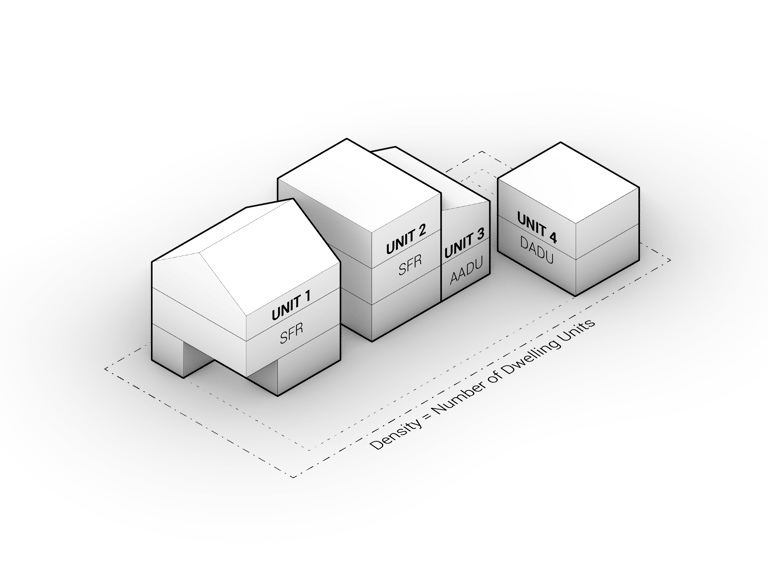

FLOOR AREA RATIO 23.44.011
Ratio of the total floor area of all levels to the lot area
0.6 if density is lesser than 1 unit / 4,000 SF (NR1, NR2, NR3 Zones only)
0.75 if density is lesser than 1 unit / 4,000 SF (RSL Zones only)
0.8 if density is between 1 unit / 4,000 SF - 1 unit / 2,201 SF
1.0 if density is between 1 unit / 2,200 SF - 1 unit / 1,601 SF
1.2 if density is greater than 1 unit / 1,600 SF
(Previously, the FAR limit in NR1, NR2, and NR3 zones was 0.5, regardless of unit density)
Notes and Exceptions
Lots less than 5,000 SF in NR1, NR2, and NR3 zones can select the greater of the above ratio or 2,500 SF gross floor area
In RSL zones, dwelling units cannot exceed 2,200 SF, except for underground stories and certain additions per 23.44.018.B
Gross floor area of an ADU cannot exceed 1,000 SF (does not include up to 250 SF of attached garage, 35 SF of bicycle parking, underground areas, exterior-only accessed storage area).
In NR1, NR2, and NR3 zones, gross floor area in ADUs are exempt from FAR limits (No change, but section has been moved to 23.42.022)
The following are not counted in FAR calculations: balconies, patios, and decks that are not used for common circulation; underground stories and parts of stories that are no more than 4 feet above grade; common wall separating attached dwelling units
In RSL zones, 50% of floor area of single family dwelling units that were built prior to Jan 1, 1982 can be excepted from FAR calculations, provided they remain in residential use.
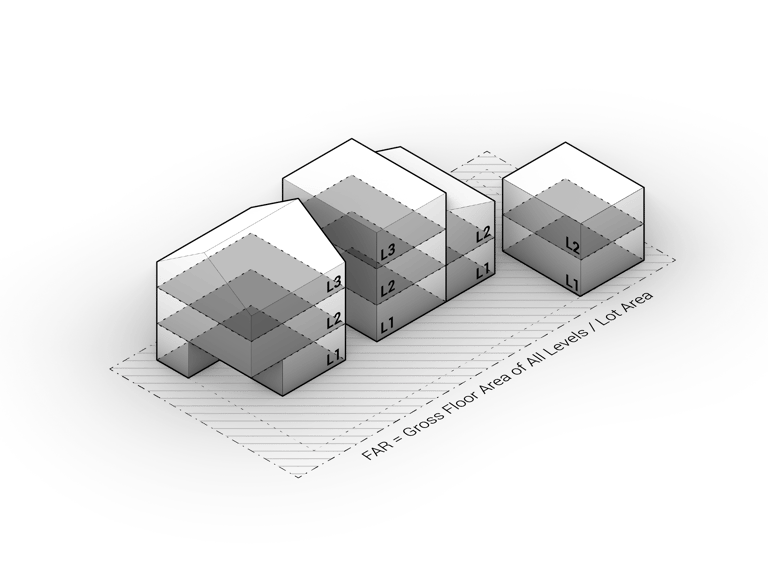

LOT COVERAGE 23.44.010.C
How much of your lot is covered by the building footprint(s)
50% of lot area if there are two or more primary and detached units
35% of lot area if there is only one unit on lots ≥5,000 SF
1,000 SF + 15% of lot area if there is only one unit on lots <5,000 SF
(Previously, there were no bonuses for increased unit density)
Notes and Exceptions
For lot coverage calculations, the area of a lot abutting an alley may be increased by ½ the width of the alley. This lot coverage exception is limited to a maximum increase of 10%.
The following are not counted in lot coverage calculations: Access Bridges, Ramps, Decks (less than 36” above existing grade), Fences and Freestanding Walls, Underground Structures, Eaves and Gutters (36” projection max.) Solar Collectors, Swimming Pools
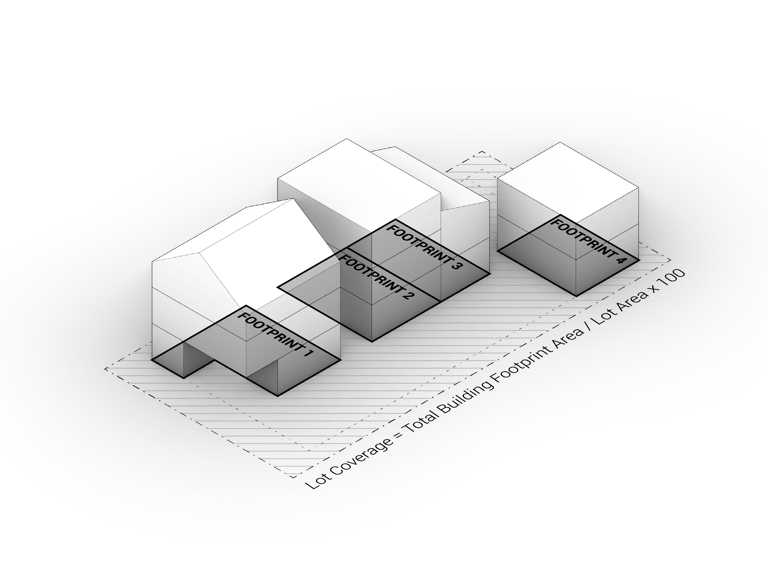

HEIGHT 23.44.012
How tall your structure can be
32 feet above the average grade level
(Previously, the height limit was 30 feet)
Notes and Exceptions
ADUs follow the same height limit as Principal Dwelling Units
The ridge of a pitched roof can extend 5 feet above the maximum height limit within a 4:12 sloped envelope. Shed and butterfly roofs cannot extend above the maximum height limit.
Open rails and planters can extend 4 feet above the maximum height limit or to the allowable height of a pitched roof.
Chimneys can extend 4 feet above the allowable roof ridge
Green roofs that have a planted coverage of at least 50% may extend up to 24 inches above the allowable height limit.
Projections that accommodate windows (dormers, clerestories, greenhouses, etc.) can extend 4 feet above the maximum height limit or to the allowable height of a pitched roof, provided that the total area of these projections is limited to 30% of the roof area. See exhibit D for 23.44.012 for further exceptions.
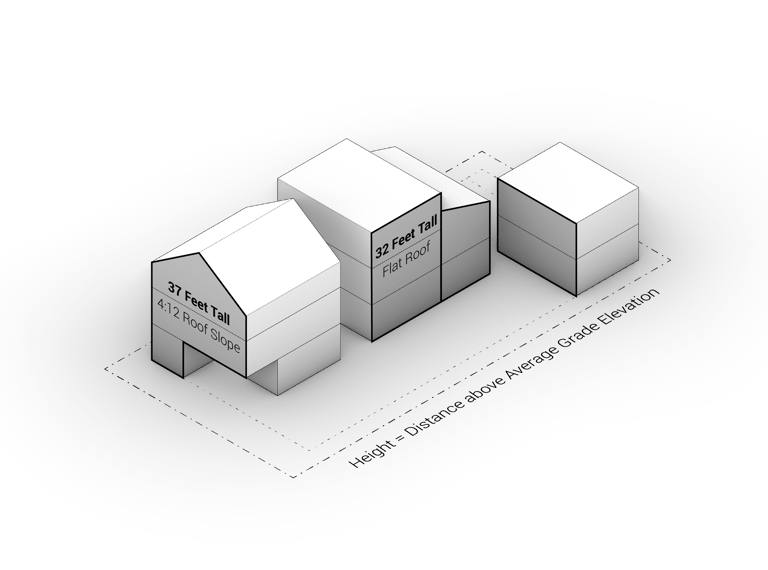

YARDS 23.44.014
How far your building(s) must be from the property lines
Front:
15 feet for lots with one or two dwelling units
10 feet for lots with three or more dwelling units
(Previously, the front yard setback limit was 10’ in RSL zones, 20’ in other NR zones)
Rear:
15 feet on lots with one or two dwelling units
10 feet on lots with three or more dwelling units
5 feet for ADUs
0 feet for lots abutting an alley
(Previously, the rear yard setback limit was 10’ in RSL zones, 25’ in other NR zones)
Side:
5 feet
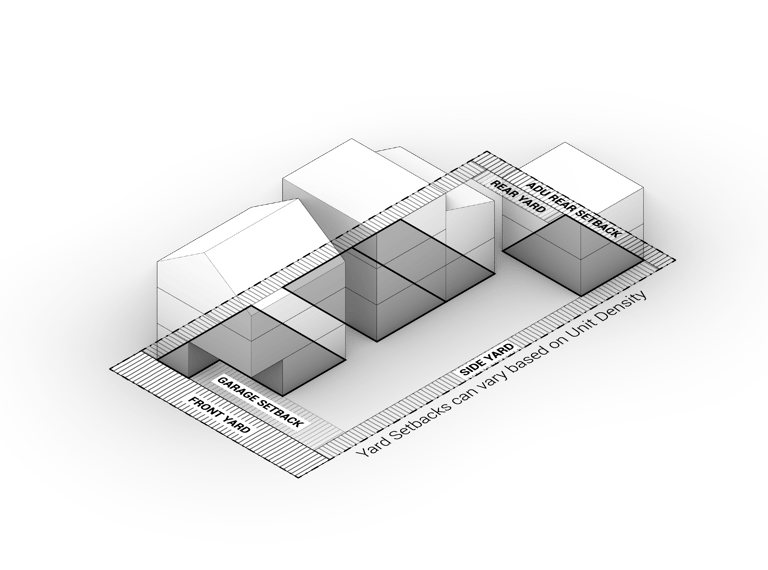

Notes and Exceptions
A detached ADU must be separated from its principal dwelling unit by a minimum of 5 ft measured from eave to eave.
An ADU is considered attached when it is connected to the principal dwelling unit by an enclosed space at least 3ft x 3ft x 3ft.
Parking and garages shall not be located within 20 feet of a front lot line.
External architectural details (chimneys, eaves, cornices, etc.) can extend 18 inches into a required yard. For DADUs, these can extend no closer than 3 feet from a property line.
Uncovered porches or steps less than 6 feet in width and depth and less than 4 feet above grade can extend into any required yard, provided it is no closer than 3 feet to any side lot line.
Bay windows less than 8 feet in width can extend 2 feet into required yards. For DADUs, these can extend no closer than 3 feet from a property line.
Ramps and other barrier free access facilities are permitted in required yards
Fences 6 feet or less in height are permitted in required yardsDecks no higher than 18 inches above grade are permitted in required yards
Heat pumps, EV charging devices, and other similar mechanical equipment are permitted within 3 feet of any lot line
For lots less than 30 feet in width in NR1, NR2, and NR3 zones, portions of the front facade more than 8 feet above finished grade may project up to 4 feet into required front yards.
TREE REQUIREMENTS 23.44.020 (No Change)
Rules to protect, preserve, and expand the urban forest
NR1, NR2, and NR3 Zones:
2 caliper inches per 1,000 SF of lot area when a new single family dwelling unit is created on a lot greater than 3,000 SF
3 caliper inches when a new single family dwelling unit is created on a lot 3,000 SF or less
2 caliper inches when a new ADU is constructed on a lot that does not currently comply with the required single family dwelling unit tree requirements.
For newly planted trees, caliper inches shall be the diameter measurement taken 6 inches above the ground. New trees shall be at least 1.5 inches in diameter.
For existing trees, caliper inches shall be based on the diameter measurement taken 4.5 feet above the ground. When an existing tree is greater than 10 inches in diameter, each 1 inch of tree diameter greater than 10 inch shall count as 3 inches toward the caliper inch requirement.
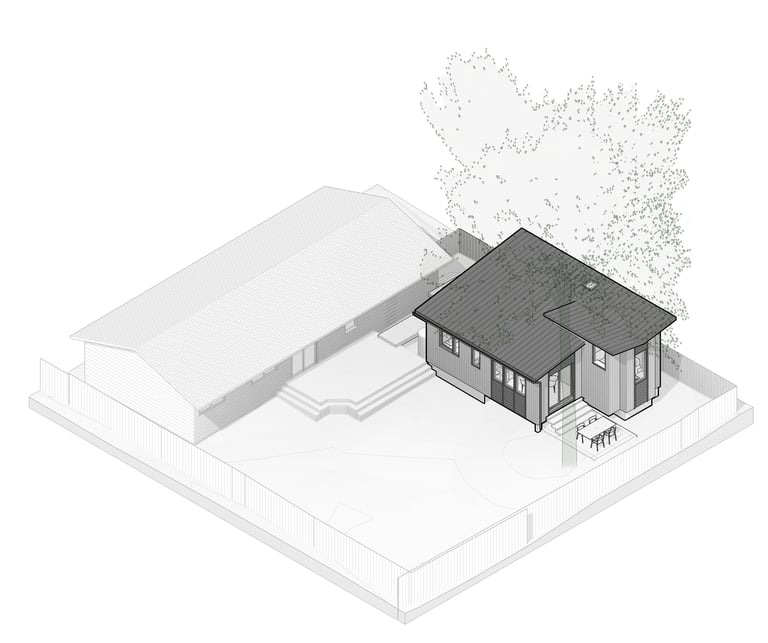

RSL Zones:
1 point per 500 square foot of lot area for any new development project containing one or more new dwelling units
Points are awarded as followed
Newly Planted Small Deciduous Tree: 1.0 point
Newly Planted Small Evergreen Tree: 1.25 point
Newly Planted Small/Med Deciduous Tree: 2.0 points
Newly Planted Small/Med Evergreen Tree: 2.5 points
Newly Planted Med/Large Deciduous Tree: 3.0 points
Newly Planted Med/Large Evergreen Tree: 3.75 points
Newly Planted Large Deciduous Tree: 4.0 points
Newly Planted Large Evergreen Tree: 5.0 points
Preserved Existing Deciduous Tree: 1.0 point per inch of diameter (min. 6 in)
Preserved Existing Evergreen Tree: 1.25 point per inch of diameter (min. 6 in)
ACCESSORY DWELLING UNITS 23.42.022 (New Section)
Secondary independent housing units on the same lot as a primary residence
Regulations regarding Accessory Dwelling Units have been relocated to section 23.42.022 as part of an earlier legislative response to HB1337.
We have already included relevant ADU rulings in the appropriate sections above, but we will also include this section to follow the formatting of the new zoning code.
Two Accessory Dwelling Units may be located on the same lot as a principal dwelling unit. ADUs are permitted in all zones where single-family dwellings are permitted
Any configuration of ADUs are allowed. Either or both ADUs may be attached or detached. Two DADUs may be located in the same structure.
The gross floor area of an ADU may not exceed 1,000 SF. This limit does not include up to 250 SF of attached garage, 35 SF of long-term bicycle storage, underground stories, or exterior-only accessed storage.
In NR1, NR2, and NR3 zones, ADU gross floor area is exempt from FAR limits.
The maximum height limit for ADUs is the the same as for principal dwelling units.
A detached ADU may be located in the rear yard no closer than 5 feet to any lot line, except if that lot line abuts an alley. There are no required yard setbacks on any lot line that abuts an alley.
A detached ADU must be separated from its principal dwelling unit by a minimum of 5 feet measured from eave to eave.
An ADU is considered attached when it is connected to the principal dwelling unit by an enclosed space at least 3 feet x 3 feet x 3 feet.
No off-street parking is required for an ADU
WHY INTERIM?
This legislature will expire on June 30th, 2026 unless extended or replaced
Seattle’s One Seattle Plan began in early 2022 as a comprehensive update to the city’s approach to growth. It laid out a long-term vision to add more housing in walkable, transit-connected areas by expanding neighborhood centers and introducing a wider mix of housing types, including fourplexes, townhouses, and stacked flats. The plan aimed to guide that growth in a way that supports affordability, livability, and neighborhood-scale density.
Then came House Bill 1110, passed by the Washington State Legislature in mid-2023. The law required cities across the state to support middle housing alternatives in areas traditionally zoned for single-family use. The bill also included a deadline: cities had until June 30, 2025, to adopt compliant zoning rules or lose local control to a uniform state model code.
Seattle’s comprehensive plan was already in progress, but it faced delays. The scope of the plan was very broad and technically complex, and it drew pushback from multiple directions. A series of lawsuits challenged the city’s environmental review, focusing on the increased lot coverage and reduced setbacks proposed in residential zones. Opponents argued that without stronger protections for trees or updated drainage standards, the changes could have negative effects on urban ecosystems and contribute to downstream impacts on habitat and marine life. While all of the lawsuits were eventually dismissed, the appeals process slowed the plan’s path to adoption.
With the state deadline approaching and the full comprehensive plan still under council review, the City pivoted. It introduced interim zoning legislation — pared down, limited in scope, and with a built-in expiration date — in order to move through a simplified legislative process while remaining in compliance with HB 1110 mandates. The ordinance was adopted in June and will remain in effect for one year, giving the City time to finalize its comprehensive plan without defaulting to the state’s model code.
Once the full plan is adopted, additional constraints and review processes may follow. These could include updated regulations on tree retention, lot coverage, and design standards, as well as changes to zoning boundaries and neighborhood center designations. There’s also momentum to make it easier to build stacked flats by adjusting how building code treats shared corridors, which are currently held to more stringent commercial standards. Those details are still in the works, but they’ll play a big role in how the city’s growth plays out once the interim rules expire.
(Disclaimer: This summary is intended as a general reference only. Zoning regulations are highly site specific and there may be other parameters not listed here that apply to your lot. We recommend working with an experienced architect to flag constraints and identify opportunities. You can schedule a free 15-minute consultation to discuss the possibilities for your site below.)

